| Listing 1 - 10 of 27 | << page >> |
Sort by
|
Book
ISBN: 1280494654 9786613589880 1400842735 9781400842735 9780691154244 0691154244 9780691154251 0691154252 9781280494659 Year: 2012 Volume: 183 Publisher: Princeton : Princeton University Press,
Abstract | Keywords | Export | Availability | Bookmark
 Loading...
Loading...Choose an application
- Reference Manager
- EndNote
- RefWorks (Direct export to RefWorks)
Mumford-Tate groups are the fundamental symmetry groups of Hodge theory, a subject which rests at the center of contemporary complex algebraic geometry. This book is the first comprehensive exploration of Mumford-Tate groups and domains. Containing basic theory and a wealth of new views and results, it will become an essential resource for graduate students and researchers. Although Mumford-Tate groups can be defined for general structures, their theory and use to date has mainly been in the classical case of abelian varieties. While the book does examine this area, it focuses on the nonclassical case. The general theory turns out to be very rich, such as in the unexpected connections of finite dimensional and infinite dimensional representation theory of real, semisimple Lie groups. The authors give the complete classification of Hodge representations, a topic that should become a standard in the finite-dimensional representation theory of noncompact, real, semisimple Lie groups. They also indicate that in the future, a connection seems ready to be made between Lie groups that admit discrete series representations and the study of automorphic cohomology on "ients of Mumford-Tate domains by arithmetic groups. Bringing together complex geometry, representation theory, and arithmetic, this book opens up a fresh perspective on an important subject.
Mumford-Tate groups. --- Geometry, Algebraic. --- Algebraic geometry --- Geometry --- Hodge theory --- Mumford-Tate groups --- Deligne torus integer. --- Galois group. --- Grothendieck conjecture. --- Hodge decomposition. --- Hodge domain. --- Hodge filtration. --- Hodge orientation. --- Hodge representation. --- Hodge structure. --- Hodge tensor. --- Hodge theory. --- Kubota rank. --- Lie algebra representation. --- Lie group. --- Mumford-Tate domain. --- Mumford-Tate group. --- Mumford-Tate subdomain. --- Noether-Lefschetz locus. --- Vogan diagram method. --- Weyl group. --- abelian variety. --- absolute Hodge class. --- algebraic geometry. --- arithmetic group. --- automorphic cohomology. --- classical group. --- compact dual. --- complex manifold. --- complex multiplication Hodge structure. --- complex multiplication. --- endomorphism algebra. --- exceptional group. --- holomorphic mapping. --- homogeneous complex manifold. --- homomorphism. --- mixed Hodge structure. --- moduli space. --- monodromy group. --- natural symmetry group. --- oriented imaginary number fields. --- period domain. --- period map. --- polarization. --- polarized Hodge structure. --- pure Hodge structure. --- reflex field. --- semisimple Lie algebra. --- semisimple Lie group. --- Γ-equivalence classes.
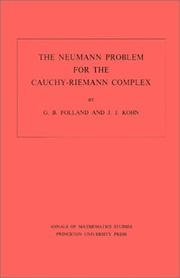
ISBN: 0691081204 1400881528 9780691081205 Year: 1972 Volume: 75 Publisher: Princeton: Princeton university press,
Abstract | Keywords | Export | Availability | Bookmark
 Loading...
Loading...Choose an application
- Reference Manager
- EndNote
- RefWorks (Direct export to RefWorks)
Part explanation of important recent work, and part introduction to some of the techniques of modern partial differential equations, this monograph is a self-contained exposition of the Neumann problem for the Cauchy-Riemann complex and certain of its applications. The authors prove the main existence and regularity theorems in detail, assuming only a knowledge of the basic theory of differentiable manifolds and operators on Hilbert space. They discuss applications to the theory of several complex variables, examine the associated complex on the boundary, and outline other techniques relevant to these problems. In an appendix they develop the functional analysis of differential operators in terms of Sobolev spaces, to the extent it is required for the monograph.
Functional analysis --- Neumann problem --- Differential operators --- Complex manifolds --- Complex manifolds. --- Differential operators. --- Neumann problem. --- Differential equations, Partial --- Équations aux dérivées partielles --- Analytic spaces --- Manifolds (Mathematics) --- Operators, Differential --- Differential equations --- Operator theory --- Boundary value problems --- A priori estimate. --- Almost complex manifold. --- Analytic function. --- Apply. --- Approximation. --- Bernhard Riemann. --- Boundary value problem. --- Calculation. --- Cauchy–Riemann equations. --- Cohomology. --- Compact space. --- Complex analysis. --- Complex manifold. --- Coordinate system. --- Corollary. --- Derivative. --- Differentiable manifold. --- Differential equation. --- Differential form. --- Differential operator. --- Dimension (vector space). --- Dirichlet boundary condition. --- Eigenvalues and eigenvectors. --- Elliptic operator. --- Equation. --- Estimation. --- Euclidean space. --- Existence theorem. --- Exterior (topology). --- Finite difference. --- Fourier analysis. --- Fourier transform. --- Frobenius theorem (differential topology). --- Functional analysis. --- Hilbert space. --- Hodge theory. --- Holomorphic function. --- Holomorphic vector bundle. --- Irreducible representation. --- Line segment. --- Linear programming. --- Local coordinates. --- Lp space. --- Manifold. --- Monograph. --- Multi-index notation. --- Nonlinear system. --- Operator (physics). --- Overdetermined system. --- Partial differential equation. --- Partition of unity. --- Potential theory. --- Power series. --- Pseudo-differential operator. --- Pseudoconvexity. --- Pseudogroup. --- Pullback. --- Regularity theorem. --- Remainder. --- Scientific notation. --- Several complex variables. --- Sheaf (mathematics). --- Smoothness. --- Sobolev space. --- Special case. --- Statistical significance. --- Sturm–Liouville theory. --- Submanifold. --- Tangent bundle. --- Theorem. --- Uniform norm. --- Vector field. --- Weight function. --- Operators in hilbert space --- Équations aux dérivées partielles
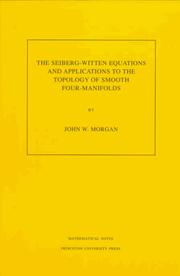
ISBN: 1400865166 9781400865161 9780691025971 0691025975 9780691025971 Year: 1996 Publisher: Princeton, New Jersey
Abstract | Keywords | Export | Availability | Bookmark
 Loading...
Loading...Choose an application
- Reference Manager
- EndNote
- RefWorks (Direct export to RefWorks)
The recent introduction of the Seiberg-Witten invariants of smooth four-manifolds has revolutionized the study of those manifolds. The invariants are gauge-theoretic in nature and are close cousins of the much-studied SU(2)-invariants defined over fifteen years ago by Donaldson. On a practical level, the new invariants have proved to be more powerful and have led to a vast generalization of earlier results. This book is an introduction to the Seiberg-Witten invariants. The work begins with a review of the classical material on Spin c structures and their associated Dirac operators. Next comes a discussion of the Seiberg-Witten equations, which is set in the context of nonlinear elliptic operators on an appropriate infinite dimensional space of configurations. It is demonstrated that the space of solutions to these equations, called the Seiberg-Witten moduli space, is finite dimensional, and its dimension is then computed. In contrast to the SU(2)-case, the Seiberg-Witten moduli spaces are shown to be compact. The Seiberg-Witten invariant is then essentially the homology class in the space of configurations represented by the Seiberg-Witten moduli space. The last chapter gives a flavor for the applications of these new invariants by computing the invariants for most Kahler surfaces and then deriving some basic toological consequences for these surfaces.
Four-manifolds (Topology) --- Seiberg-Witten invariants. --- Mathematical physics. --- Physical mathematics --- Physics --- Invariants --- 4-dimensional manifolds (Topology) --- 4-manifolds (Topology) --- Four dimensional manifolds (Topology) --- Manifolds, Four dimensional --- Low-dimensional topology --- Topological manifolds --- Mathematics --- Affine space. --- Affine transformation. --- Algebra bundle. --- Algebraic surface. --- Almost complex manifold. --- Automorphism. --- Banach space. --- Clifford algebra. --- Cohomology. --- Cokernel. --- Complex dimension. --- Complex manifold. --- Complex plane. --- Complex projective space. --- Complex vector bundle. --- Complexification (Lie group). --- Computation. --- Configuration space. --- Conjugate transpose. --- Covariant derivative. --- Curvature form. --- Curvature. --- Differentiable manifold. --- Differential topology. --- Dimension (vector space). --- Dirac equation. --- Dirac operator. --- Division algebra. --- Donaldson theory. --- Duality (mathematics). --- Eigenvalues and eigenvectors. --- Elliptic operator. --- Elliptic surface. --- Equation. --- Fiber bundle. --- Frenet–Serret formulas. --- Gauge fixing. --- Gauge theory. --- Gaussian curvature. --- Geometry. --- Group homomorphism. --- Hilbert space. --- Hodge index theorem. --- Homology (mathematics). --- Homotopy. --- Identity (mathematics). --- Implicit function theorem. --- Intersection form (4-manifold). --- Inverse function theorem. --- Isomorphism class. --- K3 surface. --- Kähler manifold. --- Levi-Civita connection. --- Lie algebra. --- Line bundle. --- Linear map. --- Linear space (geometry). --- Linearization. --- Manifold. --- Mathematical induction. --- Moduli space. --- Multiplication theorem. --- Neighbourhood (mathematics). --- One-form. --- Open set. --- Orientability. --- Orthonormal basis. --- Parameter space. --- Parametric equation. --- Parity (mathematics). --- Partial derivative. --- Principal bundle. --- Projection (linear algebra). --- Pullback (category theory). --- Quadratic form. --- Quaternion algebra. --- Quotient space (topology). --- Riemann surface. --- Riemannian manifold. --- Sard's theorem. --- Sign (mathematics). --- Sobolev space. --- Spin group. --- Spin representation. --- Spin structure. --- Spinor field. --- Subgroup. --- Submanifold. --- Surjective function. --- Symplectic geometry. --- Symplectic manifold. --- Tangent bundle. --- Tangent space. --- Tensor product. --- Theorem. --- Three-dimensional space (mathematics). --- Trace (linear algebra). --- Transversality (mathematics). --- Two-form. --- Zariski tangent space.
Book
ISBN: 1400881250 Year: 2016 Publisher: Princeton, NJ : Princeton University Press,
Abstract | Keywords | Export | Availability | Bookmark
 Loading...
Loading...Choose an application
- Reference Manager
- EndNote
- RefWorks (Direct export to RefWorks)
This book introduces the theory of complex surfaces through a comprehensive look at finite covers of the projective plane branched along line arrangements. Paula Tretkoff emphasizes those finite covers that are free "ients of the complex two-dimensional ball. Tretkoff also includes background on the classical Gauss hypergeometric function of one variable, and a chapter on the Appell two-variable F1 hypergeometric function.The material in this book began as a set of lecture notes, taken by Tretkoff, of a course given by Friedrich Hirzebruch at ETH Zürich in 1996. The lecture notes were then considerably expanded by Hirzebruch and Tretkoff over a number of years. In this book, Tretkoff has expanded those notes even further, still stressing examples offered by finite covers of line arrangements. The book is largely self-contained and foundational material is introduced and explained as needed, but not treated in full detail. References to omitted material are provided for interested readers.Aimed at graduate students and researchers, this is an accessible account of a highly informative area of complex geometry.
Curves, Elliptic. --- Geometry, Algebraic. --- Projective planes. --- Unit ball. --- Riemann surfaces. --- Surfaces, Riemann --- Functions --- Ball, Unit --- Holomorphic functions --- Planes, Projective --- Geometry, Projective --- Algebraic geometry --- Geometry --- Elliptic curves --- Curves, Algebraic --- Appell hypergeometric function. --- Chern numbers. --- Euler number. --- Friedrich Hirzebruch. --- Gauss hypergeometric function. --- Gaussian curvature. --- Hermitian metric. --- Kodaira dimension. --- Mbius transformation. --- Miyaoka-Yau inequality. --- Riemann surface. --- Riemannian metric. --- algebraic geometry. --- algebraic surface. --- arithmetic monodromy group. --- b-space. --- ball "ient. --- canonical divisor class. --- complete quadrilateral. --- complex 2-ball. --- complex manifold. --- complex surface. --- covering group. --- covering space. --- differential geometry. --- divisor class group. --- divisor. --- elliptic curve. --- finite covering. --- first Chern class. --- fractional linear transformation. --- free 2-ball "ient. --- fundamental group. --- geometry. --- intersection point. --- line arrangement. --- line bundle. --- linear arrangement. --- log-canonical divisor. --- minimal surface. --- monodromy group. --- orbifold structure. --- orbifold. --- partial differential equation. --- plurigenus. --- projective plane. --- proportionality deviation. --- ramification indices. --- rational curve. --- regular point. --- signature. --- solution space. --- topological invariant. --- transversely intersecting divisor. --- triangle groups. --- weight.
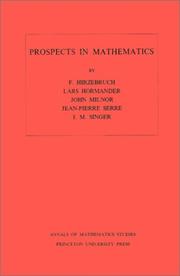
ISBN: 0691080941 9780691080949 1400881692 Year: 1971 Volume: 70 Publisher: Princeton: Princeton university press,
Abstract | Keywords | Export | Availability | Bookmark
 Loading...
Loading...Choose an application
- Reference Manager
- EndNote
- RefWorks (Direct export to RefWorks)
Five papers by distinguished American and European mathematicians describe some current trends in mathematics in the perspective of the recent past and in terms of expectations for the future. Among the subjects discussed are algebraic groups, quadratic forms, topological aspects of global analysis, variants of the index theorem, and partial differential equations.
Mathematics --- Mathématiques --- Congresses --- Congrès --- 51 --- -Math --- Science --- Congresses. --- -Mathematics --- 51 Mathematics --- -51 Mathematics --- Math --- Mathématiques --- Congrès --- A priori estimate. --- Addition. --- Additive group. --- Affine space. --- Algebraic geometry. --- Algebraic group. --- Atiyah–Singer index theorem. --- Bernoulli number. --- Boundary value problem. --- Bounded operator. --- C*-algebra. --- Canonical transformation. --- Cauchy problem. --- Characteristic class. --- Clifford algebra. --- Coefficient. --- Cohomology. --- Commutative property. --- Commutative ring. --- Complex manifold. --- Complex number. --- Complex vector bundle. --- Dedekind sum. --- Degenerate bilinear form. --- Diagram (category theory). --- Diffeomorphism. --- Differentiable manifold. --- Differential operator. --- Dimension (vector space). --- Ellipse. --- Elliptic operator. --- Equation. --- Euler characteristic. --- Euler number. --- Existence theorem. --- Exotic sphere. --- Finite difference. --- Finite group. --- Fourier integral operator. --- Fourier transform. --- Fourier. --- Fredholm operator. --- Hardy space. --- Hilbert space. --- Holomorphic vector bundle. --- Homogeneous coordinates. --- Homomorphism. --- Homotopy. --- Hyperbolic partial differential equation. --- Identity component. --- Integer. --- Integral transform. --- Isomorphism class. --- John Milnor. --- K-theory. --- Lebesgue measure. --- Line bundle. --- Local ring. --- Mathematics. --- Maximal ideal. --- Modular form. --- Module (mathematics). --- Monoid. --- Normal bundle. --- Number theory. --- Open set. --- Parametrix. --- Parity (mathematics). --- Partial differential equation. --- Piecewise linear manifold. --- Poisson bracket. --- Polynomial ring. --- Polynomial. --- Prime number. --- Principal part. --- Projective space. --- Pseudo-differential operator. --- Quadratic form. --- Rational variety. --- Real number. --- Reciprocity law. --- Resolution of singularities. --- Riemann–Roch theorem. --- Shift operator. --- Simply connected space. --- Special case. --- Square-integrable function. --- Subalgebra. --- Submanifold. --- Support (mathematics). --- Surjective function. --- Symmetric bilinear form. --- Symplectic vector space. --- Tangent space. --- Theorem. --- Topology. --- Variable (mathematics). --- Vector bundle. --- Vector space. --- Winding number. --- Mathematics - Congresses
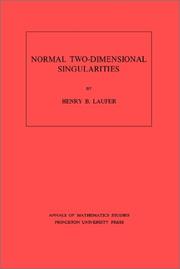
ISBN: 069108100X 1400881749 9780691081007 Year: 1971 Volume: 71 Publisher: Princeton (N.J.): Princeton university press,
Abstract | Keywords | Export | Availability | Bookmark
 Loading...
Loading...Choose an application
- Reference Manager
- EndNote
- RefWorks (Direct export to RefWorks)
A survey, thorough and timely, of the singularities of two-dimensional normal complex analytic varieties, the volume summarizes the results obtained since Hirzebruch's thesis (1953) and presents new contributions. First, the singularity is resolved and shown to be classified by its resolution; then, resolutions are classed by the use of spaces with nilpotents; finally, the spaces with nilpotents are determined by means of the local ring structure of the singularity.
Algebraic geometry --- Analytic spaces --- SINGULARITIES (Mathematics) --- 512.76 --- Singularities (Mathematics) --- Geometry, Algebraic --- Spaces, Analytic --- Analytic functions --- Functions of several complex variables --- Birational geometry. Mappings etc. --- Analytic spaces. --- Singularities (Mathematics). --- 512.76 Birational geometry. Mappings etc. --- Birational geometry. Mappings etc --- Analytic function. --- Analytic set. --- Analytic space. --- Automorphism. --- Bernhard Riemann. --- Big O notation. --- Calculation. --- Chern class. --- Codimension. --- Coefficient. --- Cohomology. --- Compact Riemann surface. --- Complex manifold. --- Computation. --- Connected component (graph theory). --- Continuous function. --- Contradiction. --- Coordinate system. --- Corollary. --- Covering space. --- Dimension. --- Disjoint union. --- Divisor. --- Dual graph. --- Elliptic curve. --- Elliptic function. --- Embedding. --- Existential quantification. --- Factorization. --- Fiber bundle. --- Finite set. --- Formal power series. --- Hausdorff space. --- Holomorphic function. --- Homeomorphism. --- Homology (mathematics). --- Intersection (set theory). --- Intersection number (graph theory). --- Inverse limit. --- Irreducible component. --- Isolated singularity. --- Iteration. --- Lattice (group). --- Line bundle. --- Linear combination. --- Line–line intersection. --- Local coordinates. --- Local ring. --- Mathematical induction. --- Maximal ideal. --- Meromorphic function. --- Monic polynomial. --- Nilpotent. --- Normal bundle. --- Open set. --- Parameter. --- Plane curve. --- Pole (complex analysis). --- Power series. --- Presheaf (category theory). --- Projective line. --- Quadratic transformation. --- Quantity. --- Riemann surface. --- Riemann–Roch theorem. --- Several complex variables. --- Submanifold. --- Subset. --- Tangent bundle. --- Tangent space. --- Tensor algebra. --- Theorem. --- Topological space. --- Transition function. --- Two-dimensional space. --- Variable (mathematics). --- Zero divisor. --- Zero of a function. --- Zero set. --- Variétés complexes --- Espaces analytiques
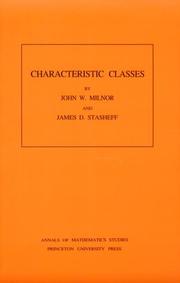
ISBN: 0691081220 9780691081229 140088182X Year: 1974 Volume: 76 Publisher: Princeton (N.J.): Princeton university press,
Abstract | Keywords | Export | Availability | Bookmark
 Loading...
Loading...Choose an application
- Reference Manager
- EndNote
- RefWorks (Direct export to RefWorks)
The theory of characteristic classes provides a meeting ground for the various disciplines of differential topology, differential and algebraic geometry, cohomology, and fiber bundle theory. As such, it is a fundamental and an essential tool in the study of differentiable manifolds.In this volume, the authors provide a thorough introduction to characteristic classes, with detailed studies of Stiefel-Whitney classes, Chern classes, Pontrjagin classes, and the Euler class. Three appendices cover the basics of cohomology theory and the differential forms approach to characteristic classes, and provide an account of Bernoulli numbers.Based on lecture notes of John Milnor, which first appeared at Princeton University in 1957 and have been widely studied by graduate students of topology ever since, this published version has been completely revised and corrected.
Algebraic topology --- Characteristic classes --- Classes caractéristiques --- 515.16 --- #WWIS:d.d. Prof. L. Bouckaert/ALTO --- Classes, Characteristic --- Differential topology --- Topology of manifolds --- Characteristic classes. --- 515.16 Topology of manifolds --- Classes caractéristiques --- Additive group. --- Axiom. --- Basis (linear algebra). --- Boundary (topology). --- Bundle map. --- CW complex. --- Canonical map. --- Cap product. --- Cartesian product. --- Characteristic class. --- Charles Ehresmann. --- Chern class. --- Classifying space. --- Coefficient. --- Cohomology ring. --- Cohomology. --- Compact space. --- Complex dimension. --- Complex manifold. --- Complex vector bundle. --- Complexification. --- Computation. --- Conformal geometry. --- Continuous function. --- Coordinate space. --- Cross product. --- De Rham cohomology. --- Diffeomorphism. --- Differentiable manifold. --- Differential form. --- Differential operator. --- Dimension (vector space). --- Dimension. --- Direct sum. --- Directional derivative. --- Eilenberg–Steenrod axioms. --- Embedding. --- Equivalence class. --- Euler class. --- Euler number. --- Existence theorem. --- Existential quantification. --- Exterior (topology). --- Fiber bundle. --- Fundamental class. --- Fundamental group. --- General linear group. --- Grassmannian. --- Gysin sequence. --- Hausdorff space. --- Homeomorphism. --- Homology (mathematics). --- Homotopy. --- Identity element. --- Integer. --- Interior (topology). --- Isomorphism class. --- J-homomorphism. --- K-theory. --- Leibniz integral rule. --- Levi-Civita connection. --- Limit of a sequence. --- Linear map. --- Metric space. --- Natural number. --- Natural topology. --- Neighbourhood (mathematics). --- Normal bundle. --- Open set. --- Orthogonal complement. --- Orthogonal group. --- Orthonormal basis. --- Partition of unity. --- Permutation. --- Polynomial. --- Power series. --- Principal ideal domain. --- Projection (mathematics). --- Representation ring. --- Riemannian manifold. --- Sequence. --- Singular homology. --- Smoothness. --- Special case. --- Steenrod algebra. --- Stiefel–Whitney class. --- Subgroup. --- Subset. --- Symmetric function. --- Tangent bundle. --- Tensor product. --- Theorem. --- Thom space. --- Topological space. --- Topology. --- Unit disk. --- Unit vector. --- Variable (mathematics). --- Vector bundle. --- Vector space. --- Topologie differentielle --- Classes caracteristiques --- Classes et nombres caracteristiques
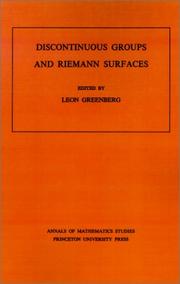
ISBN: 0691081387 1400881641 9780691081380 Year: 1974 Volume: 79 Publisher: Princeton: Princeton university press,
Abstract | Keywords | Export | Availability | Bookmark
 Loading...
Loading...Choose an application
- Reference Manager
- EndNote
- RefWorks (Direct export to RefWorks)
Study 79 contains a collection of papers presented at the Conference on Discontinuous Groups and Ricmann Surfaces at the University of Maryland, May 21-25, 1973. The papers, by leading authorities, deal mainly with Fuchsian and Kleinian groups, Teichmüller spaces, Jacobian varieties, and quasiconformal mappings. These topics are intertwined, representing a common meeting of algebra, geometry, and analysis.
Group theory --- Complex analysis --- Number theory --- RIEMANN SURFACES --- Discontinuous groups --- congresses --- Congresses --- Riemann surfaces --- Congresses. --- Groupes discontinus --- Combinatorial topology --- Functions of complex variables --- Surfaces, Riemann --- Functions --- Abelian variety. --- Adjunction (field theory). --- Affine space. --- Algebraic curve. --- Algebraic structure. --- Analytic function. --- Arithmetic genus. --- Automorphism. --- Bernhard Riemann. --- Boundary (topology). --- Cauchy sequence. --- Cauchy–Schwarz inequality. --- Cayley–Hamilton theorem. --- Closed geodesic. --- Combination. --- Commutative diagram. --- Commutator subgroup. --- Compact Riemann surface. --- Complex dimension. --- Complex manifold. --- Complex multiplication. --- Complex space. --- Complex torus. --- Congruence subgroup. --- Conjugacy class. --- Convex set. --- Cyclic group. --- Degeneracy (mathematics). --- Diagram (category theory). --- Diffeomorphism. --- Differential form. --- Dimension (vector space). --- Disjoint sets. --- E7 (mathematics). --- Endomorphism. --- Equation. --- Equivalence class. --- Euclidean space. --- Existence theorem. --- Existential quantification. --- Finite group. --- Finitely generated group. --- Fuchsian group. --- Fundamental domain. --- Fundamental lemma (Langlands program). --- Fundamental polygon. --- Galois extension. --- Holomorphic function. --- Homeomorphism. --- Homology (mathematics). --- Homomorphism. --- Hurwitz's theorem (number theory). --- Inclusion map. --- Inequality (mathematics). --- Inner automorphism. --- Intersection (set theory). --- Irreducibility (mathematics). --- Isomorphism class. --- Isomorphism theorem. --- Jacobian variety. --- Jordan curve theorem. --- Kleinian group. --- Limit point. --- Mapping class group. --- Metric space. --- Monodromy. --- Monomorphism. --- Möbius transformation. --- Non-Euclidean geometry. --- Orthogonal trajectory. --- Permutation. --- Polynomial. --- Power series. --- Projective variety. --- Quadratic differential. --- Quadric. --- Quasi-projective variety. --- Quasiconformal mapping. --- Quotient space (topology). --- Rectangle. --- Riemann mapping theorem. --- Riemann surface. --- Schwarzian derivative. --- Simply connected space. --- Simultaneous equations. --- Special case. --- Subgroup. --- Subsequence. --- Surjective function. --- Symmetric space. --- Tangent space. --- Teichmüller space. --- Theorem. --- Topological space. --- Topology. --- Uniqueness theorem. --- Unit disk. --- Variable (mathematics). --- Winding number. --- Word problem (mathematics). --- RIEMANN SURFACES - congresses --- Discontinuous groups - Congresses --- Geometrie algebrique --- Fonctions d'une variable complexe --- Surfaces de riemann
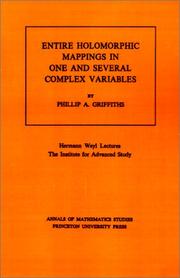
ISBN: 0691081719 0691081727 140088148X 9780691081724 9780691081717 Year: 1976 Volume: no. 85 Publisher: Princeton (N.J.): Princeton university press,
Abstract | Keywords | Export | Availability | Bookmark
 Loading...
Loading...Choose an application
- Reference Manager
- EndNote
- RefWorks (Direct export to RefWorks)
The present monograph grew out of the fifth set of Hermann Weyl Lectures, given by Professor Griffiths at the Institute for Advanced Study, Princeton, in fall 1974.In Chapter 1 the author discusses Emile Borel's proof and the classical Jensen theorem, order of growth of entire analytic sets, order functions for entire holomorphic mappings, classical indicators of orders of growth, and entire functions and varieties of finite order.Chapter 2 is devoted to the appearance of curvature, and Chapter 3 considers the defect relations. The author considers the lemma on the logarithmic derivative, R. Nevanlinna's proof of the defect relation, and refinements of the classical case.
Complex analysis --- Holomorphic mappings --- Applications holomorphes --- 517.53 --- Mappings, Holomorphic --- Functions of several complex variables --- Mappings (Mathematics) --- Functions of a complex variable --- Holomorphic mappings. --- 517.53 Functions of a complex variable --- Fonctions de plusieurs variables complexes --- Fonctions entières --- Functions, Entire --- Algebraic variety. --- Analytic function. --- Analytic set. --- Armand Borel. --- Big O notation. --- Canonical bundle. --- Cartesian coordinate system. --- Characteristic function (probability theory). --- Characterization (mathematics). --- Chern class. --- Compact Riemann surface. --- Compact space. --- Complex analysis. --- Complex manifold. --- Complex projective space. --- Corollary. --- Counting. --- Curvature. --- Degeneracy (mathematics). --- Derivative. --- Differential form. --- Dimension. --- Divisor. --- Elementary proof. --- Entire function. --- Equation. --- Exponential growth. --- Gaussian curvature. --- Hermann Weyl. --- Hodge theory. --- Holomorphic function. --- Hyperplane. --- Hypersurface. --- Infinite product. --- Integral geometry. --- Invariant measure. --- Inverse problem. --- Jacobian matrix and determinant. --- Kähler manifold. --- Line bundle. --- Linear equation. --- Logarithmic derivative. --- Manifold. --- Meromorphic function. --- Modular form. --- Monograph. --- Nevanlinna theory. --- Nonlinear system. --- Phillip Griffiths. --- Picard theorem. --- Polynomial. --- Projective space. --- Q.E.D. --- Quantity. --- Ricci curvature. --- Riemann sphere. --- Scientific notation. --- Several complex variables. --- Special case. --- Stokes' theorem. --- Subset. --- Summation. --- Theorem. --- Theory. --- Uniformization theorem. --- Unit square. --- Volume form. --- Fonctions entières
Book
ISBN: 0691080135 1400869226 Year: 1977 Publisher: Princeton (N.J.) : Princeton university press,
Abstract | Keywords | Export | Availability | Bookmark
 Loading...
Loading...Choose an application
- Reference Manager
- EndNote
- RefWorks (Direct export to RefWorks)
The ∂̄ Neumann problem is probably the most important and natural example of a non-elliptic boundary value problem, arising as it does from the Cauchy-Riemann equations. It has been known for some time how to prove solvability and regularity by the use of L2 methods. In this monograph the authors apply recent methods involving the Heisenberg group to obtain parametricies and to give sharp estimates in various function spaces, leading to a better understanding of the ∂̄ Neumann problem. The authors have added substantial background material to make the monograph more accessible to students.Originally published in 1977.The Princeton Legacy Library uses the latest print-on-demand technology to again make available previously out-of-print books from the distinguished backlist of Princeton University Press. These editions preserve the original texts of these important books while presenting them in durable paperback and hardcover editions. The goal of the Princeton Legacy Library is to vastly increase access to the rich scholarly heritage found in the thousands of books published by Princeton University Press since its founding in 1905.
Partial differential equations --- Neumann problem. --- Neumann problem --- Mathematics --- Physical Sciences & Mathematics --- Calculus --- Boundary value problems --- Differential equations, Partial --- A priori estimate. --- Abuse of notation. --- Analytic continuation. --- Analytic function. --- Approximation. --- Asymptotic expansion. --- Asymptotic formula. --- Basis (linear algebra). --- Besov space. --- Boundary (topology). --- Boundary value problem. --- Boundedness. --- Calculation. --- Cauchy's integral formula. --- Cauchy–Riemann equations. --- Change of variables. --- Characterization (mathematics). --- Combination. --- Commutative property. --- Commutator. --- Complex analysis. --- Complex manifold. --- Complex number. --- Computation. --- Convolution. --- Coordinate system. --- Corollary. --- Counterexample. --- Derivative. --- Determinant. --- Differential equation. --- Dimension (vector space). --- Dimension. --- Dimensional analysis. --- Dirichlet boundary condition. --- Eigenvalues and eigenvectors. --- Elliptic boundary value problem. --- Equation. --- Error term. --- Estimation. --- Even and odd functions. --- Existential quantification. --- Function space. --- Fundamental solution. --- Green's theorem. --- Half-space (geometry). --- Hardy's inequality. --- Heisenberg group. --- Holomorphic function. --- Infimum and supremum. --- Integer. --- Integral curve. --- Integral expression. --- Inverse function. --- Invertible matrix. --- Iteration. --- Laplace's equation. --- Left inverse. --- Lie algebra. --- Lie group. --- Linear combination. --- Logarithm. --- Lp space. --- Mathematical induction. --- Neumann boundary condition. --- Notation. --- Open problem. --- Orthogonal complement. --- Orthogonality. --- Parametrix. --- Partial derivative. --- Pointwise. --- Polynomial. --- Principal branch. --- Principal part. --- Projection (linear algebra). --- Pseudo-differential operator. --- Quantity. --- Recursive definition. --- Schwartz space. --- Scientific notation. --- Second derivative. --- Self-adjoint. --- Singular value. --- Sobolev space. --- Special case. --- Standard basis. --- Stein manifold. --- Subgroup. --- Subset. --- Summation. --- Support (mathematics). --- Tangent bundle. --- Theorem. --- Theory. --- Upper half-plane. --- Variable (mathematics). --- Vector field. --- Volume element. --- Weak solution. --- Neumann, Problème de --- Equations aux derivees partielles --- Problemes aux limites
| Listing 1 - 10 of 27 | << page >> |
Sort by
|

 Search
Search Feedback
Feedback About UniCat
About UniCat  Help
Help News
News